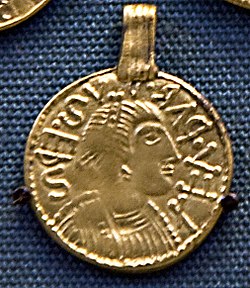Liudhard medalet

Replica of the Liudhard medalet from the British Museum
|
|
| Material | Gold |
|---|---|
| Size | 1.57 grams (0.055 oz) |
| Writing | Latin inscription |
| Created | late 6th century AD |
| Discovered | 1840s |
| Present location | currently in the World Museum Liverpool |
| Identification | M7018 at the World Museum Liverpool |
The Liudhard medalet is a gold Anglo-Saxon coin or small medal found some time before 1844 near St Martin's Church in Canterbury, England. It was part of the Canterbury-St Martin's hoard of six items. The coin, along with other items found with it, now resides in the World Museum Liverpool. Although some scholarly debate exists on whether or not all the items in the hoard were from the same grave, most historians who have studied the object conclude that they were buried together as a necklace in a 6th-century woman's grave. The coin is set in a mount so that it could be worn as jewellery, and has an inscription on the obverse or front surrounding a robed figure. The inscription refers to Liudhard, a bishop who accompanied Bertha to England when she married Æthelberht the king of Kent. The reverse side of the coin has a double-barred cross, or patriarchal cross, with more lettering.
The coin was probably struck at Canterbury in the late 6th century, most likely between 578 and 589. Although it could have been used as a coin, it was more likely made as a medallion to proclaim the wearer's conversion to Christianity. The coin is the oldest surviving example of Anglo-Saxon coinage. The design of the figured side has some affinities with Merovingian and Visigothic coins, but the side with the cross has few known predecessors in coinage, and is the first northern European depiction of a patriarchal cross in any medium.
The medalet was first revealed to the public on 25 April 1844 by Charles Roach Smith, who presented it along with other coins found with it, to a meeting of the Numismatic Society. The medalet, along with two other similar items, had been acquired by W. H. Rolfe, who later acquired five other items from the same hoard, and all eight items were published in the Society's Numismatic Chronicle in 1845. About the origins and circumstances of the finding of the hoard, Smith only knew that they had been found "a few years since", and that all of the items had been found together. There may have been further items that were found but not preserved. All of the items were found in the churchyard of St Martin's in the east of Canterbury according to Rolfe, although the first published account stated that it was found next door at St Augustine's Abbey instead of St Martin's.
...
Wikipedia
